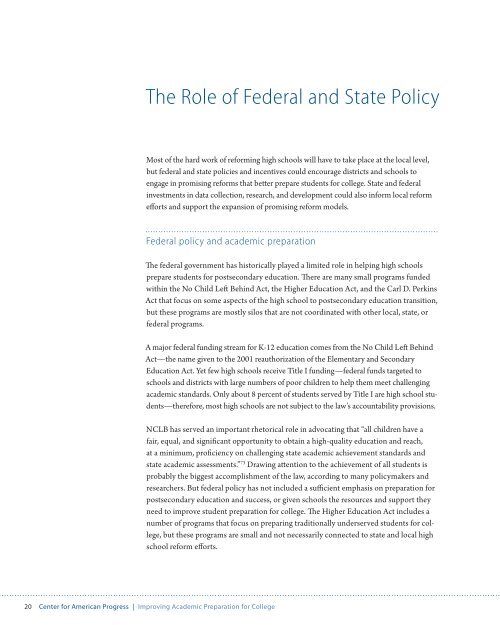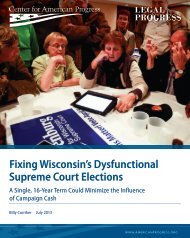Improving Academic Preparation for College - Center for American ...
Improving Academic Preparation for College - Center for American ...
Improving Academic Preparation for College - Center for American ...
Create successful ePaper yourself
Turn your PDF publications into a flip-book with our unique Google optimized e-Paper software.
The Role of Federal and State Policy<br />
Most of the hard work of re<strong>for</strong>ming high schools will have to take place at the local level,<br />
but federal and state policies and incentives could encourage districts and schools to<br />
engage in promising re<strong>for</strong>ms that better prepare students <strong>for</strong> college. State and federal<br />
investments in data collection, research, and development could also in<strong>for</strong>m local re<strong>for</strong>m<br />
ef<strong>for</strong>ts and support the expansion of promising re<strong>for</strong>m models.<br />
Federal policy and academic preparation<br />
The federal government has historically played a limited role in helping high schools<br />
prepare students <strong>for</strong> postsecondary education. There are many small programs funded<br />
within the No Child Left Behind Act, the Higher Education Act, and the Carl D. Perkins<br />
Act that focus on some aspects of the high school to postsecondary education transition,<br />
but these programs are mostly silos that are not coordinated with other local, state, or<br />
federal programs.<br />
A major federal funding stream <strong>for</strong> K-12 education comes from the No Child Left Behind<br />
Act—the name given to the 2001 reauthorization of the Elementary and Secondary<br />
Education Act. Yet few high schools receive Title I funding—federal funds targeted to<br />
schools and districts with large numbers of poor children to help them meet challenging<br />
academic standards. Only about 8 percent of students served by Title I are high school students—there<strong>for</strong>e,<br />
most high schools are not subject to the law’s accountability provisions.<br />
NCLB has served an important rhetorical role in advocating that “all children have a<br />
fair, equal, and significant opportunity to obtain a high-quality education and reach,<br />
at a minimum, proficiency on challenging state academic achievement standards and<br />
state academic assessments.” 73 Drawing attention to the achievement of all students is<br />
probably the biggest accomplishment of the law, according to many policymakers and<br />
researchers. But federal policy has not included a sufficient emphasis on preparation <strong>for</strong><br />
postsecondary education and success, or given schools the resources and support they<br />
need to improve student preparation <strong>for</strong> college. The Higher Education Act includes a<br />
number of programs that focus on preparing traditionally underserved students <strong>for</strong> college,<br />
but these programs are small and not necessarily connected to state and local high<br />
school re<strong>for</strong>m ef<strong>for</strong>ts.<br />
20 <strong>Center</strong> <strong>for</strong> american progress | improving academic preparation <strong>for</strong> <strong>College</strong>









